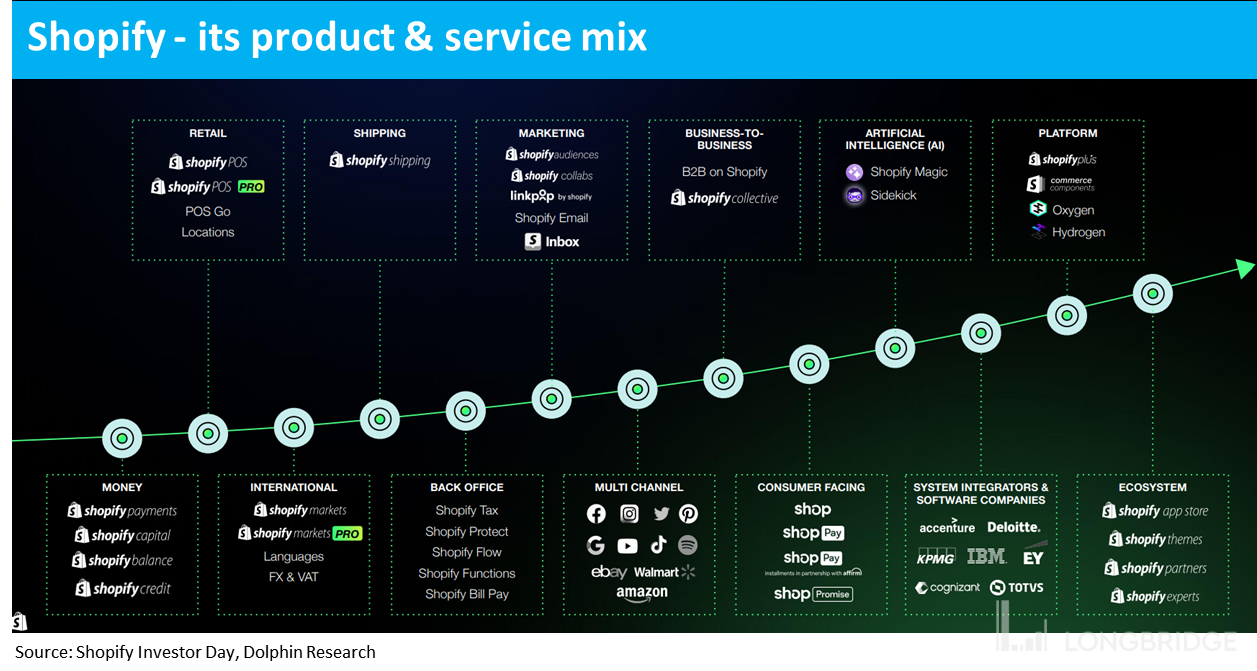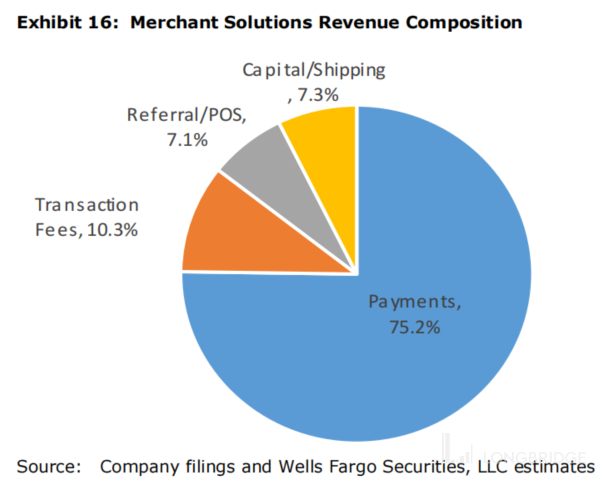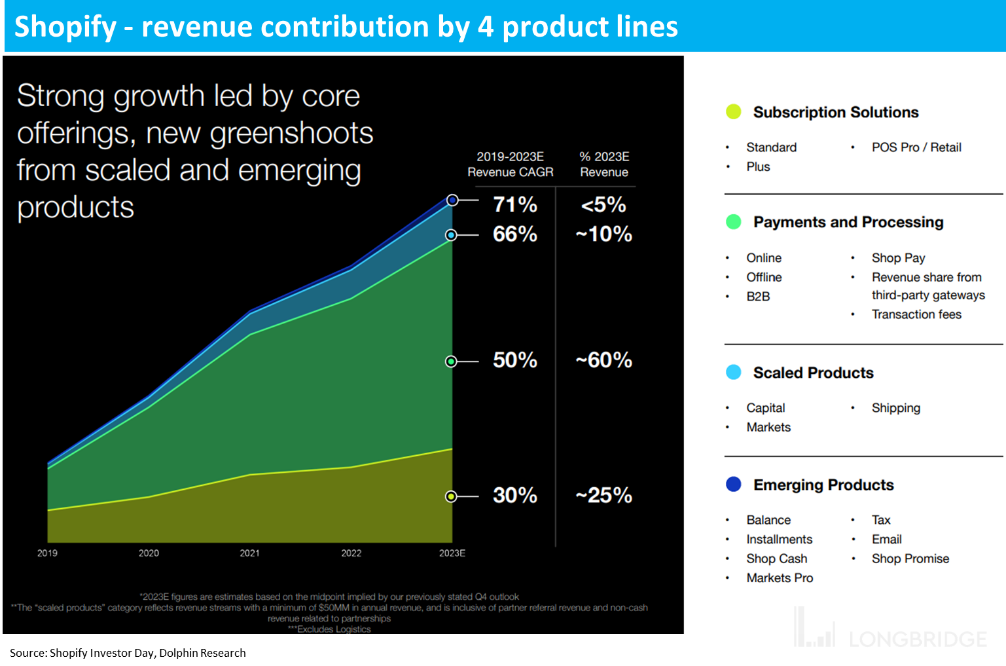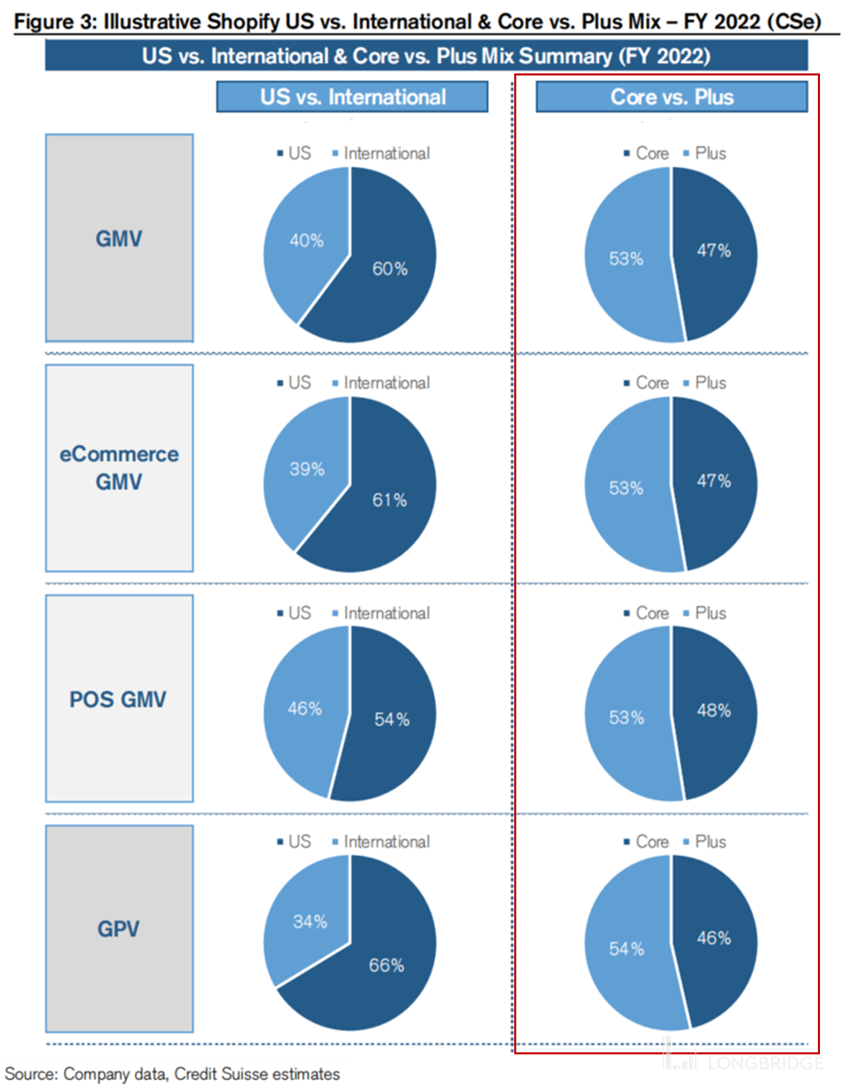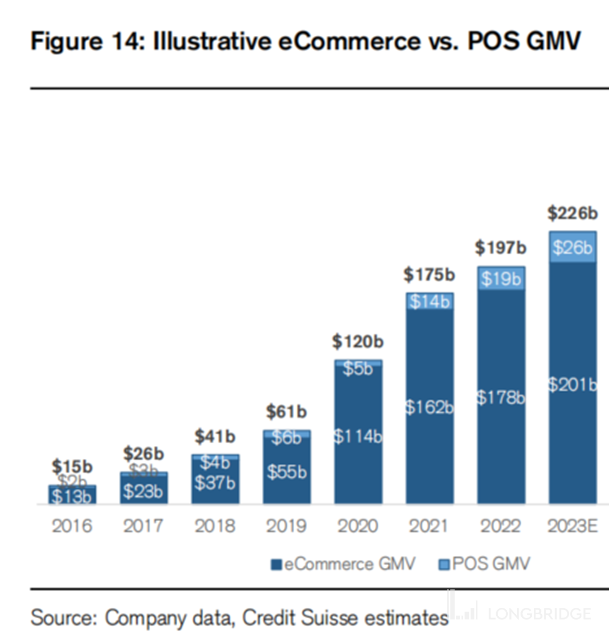
 Likes Received
Likes Received Posts
PostsShopify: No.2 ecommerce player in US who looks like "Taobao", but actually more "Ant group"

The recent performance of the domestic stock market has been evident to everyone. Although Dolphin Research believes that many high-quality assets in China have indeed entered the undervalued range, the temporary performance of the stock market may not necessarily reflect the company's performance and value. Moreover, not all investors can tolerate the path of value regression.
At the same time, purely based on the needs of investors themselves, it may not be wise to choose to rely solely on one tree when there are opportunities for global allocation. Therefore, we will gradually increase coverage of global high-quality assets. Today, we have chosen Shopify, which ranks second in the US in terms of GMV and 19th in market value among US stock service companies.
Since most investors (including us) may not be familiar with this small giant company, this research will focus on clarifying and answering specific questions about Shopify's business model, revenue and profit sources, core business, and competitiveness. This will help us gain a deeper understanding of what kind of company Shopify is, so that we can conduct more in-depth analysis in the future.
The following is a detailed analysis:
I. What kind of company is Shopify?
1. The scale and position of Shopify
As the first research on Shopify, the first question to be answered is naturally what kind of company Shopify is, which is not well known to most domestic investors (including us).
According to 3Q23 data, the annual run-rate GMV is approximately $225 billion, second only to Amazon; GPV (payment amount) is $131.2 billion;
The annual run-rate revenue is approximately $6.86 billion (corresponding to a P/S valuation of approximately 15x), but the operating profit in 3Q23 is only $120 million, and stable consecutive profitability has not yet been achieved.
Based on the above figures alone, it can be roughly seen that Shopify is a company with a leading market share and position in the e-commerce and payment fields in Europe and the United States. It also has the characteristics of a typical SaaS company with a large scale but thin profit, and high market value and valuation (in an absolute sense).
2. What is Shopify's business model?
As another characteristic of SaaS companies, Shopify has a wide range of products and services, including various online store building and operation SaaS tools, e-commerce fulfillment-related services such as payment and logistics, financial services for merchants and consumers, and recently launched advertising tools and other various functions. The company's business is relatively complex, so the following text will first summarize the categories of the company's business based on the company's development timeline.


① Online Store Building SaaS Tool Stage: Since its establishment in 2006, Shopify's main business and service have been to provide low-cost and low-threshold tools for small and medium-sized merchants who lack professional skills or funds to build online stores (websites).
Subsequently, based on the various tools required for merchant operations, Shopify opened up the Shopify apps platform, allowing third-party developers to provide various plugin functions to merchants, further enriching the ecosystem of store-building SaaS tools. At this time, Shopify's positioning is mainly a pure SaaS tool provider.
② Introduction of Payment and Logistics, Similar to E-commerce Platforms: Following the needs of merchants, Shopify introduced payment (Shopify payments) and fulfillment logistics (Shopify shipping) services between 2013 and 2015. This marked that Shopify, in the entire online transaction process of "store building - customer acquisition - transaction/payment - fulfillment - after-sales," has basically provided all the core functions needed for e-commerce operations except for customer acquisition. In other words, during this stage, Shopify's positioning is similar to an e-commerce platform.
③ Service Enrichment and Diversification Stage: From 2015 to 2017 (roughly), Shopify continued to strengthen the three core functions of the e-commerce platform: "store building - customer acquisition - transaction/payment - fulfillment." This includes but is not limited to cooperating with Pinterest, Facebook, and other platforms, allowing Shopify merchants to directly attract transactions on social media platforms and enhance customer acquisition capabilities. Shopify introduced third-party payment channels such as Apple Pay and launched its own Shopify Pay to enhance the applicability and convenience of payments. Shopify also collaborated with Amazon, allowing Shopify merchants to directly import their independent store into Amazon. After strengthening during this stage, Shopify has become an almost mature e-commerce platform. The only qualitative difference between Shopify and Amazon is that Shopify still lacks a centralized traffic platform for attracting and distributing traffic, instead allowing merchants to achieve this on other traffic platforms.
④ Diversification and Omni-channel Stage: From 2018 to the present, after perfecting its functions and establishing itself as the second-largest e-commerce platform in the United States, Shopify has entered a stage of business diversification and breaking boundaries. First of all, in terms of services, Shopify has extended its functionality from online merchants to include general SaaS tools such as tax payment, salary, and employee management, while still focusing on store building, online payment, and logistics fulfillment. It has also expanded its services to include Shopify POS offline payment, acquiring businesses, and providing financial services such as loans and working capital to merchants.
Due to the shift from e-commerce-specific services to more universal services, Shopify's customer base is no longer limited to online businesses but has expanded to include offline merchants and B2B enterprises. In summary, Shopify is no longer confined to being a "e-commerce platform" but has positioned itself as a provider of store management tools and financial payment tools, expanding its reach to online, offline, and B2B users.
It is also worth noting that in July 2022, Shopify acquired logistics service provider Deliverr to strengthen its fulfillment capabilities, but just a year later, it sold its entire logistics business, Shopify Shipping, to Flexport. Dolphin Research believes that Shopify's significant reversal in attitude towards fulfillment services in a short period of time, apart from possibly being pressured by a drop in stock price and macro headwinds, also reflects the company's return from being a "e-commerce platform" to a SaaS company.
2、How does Shopify make money?
In the previous section, we summarized the business development and evolution of Shopify since its inception, as well as its current strategic direction. So, when it comes to the company's revenue and profit, what is Shopify's profit model?
According to the company's financial disclosures, the company's revenue comes from two main categories - subscription services revenue and merchant services revenue. As we can see, with the company's total revenue growing nearly tenfold between 2017 and 2022, the revenue composition of merchant services and subscription services has gradually shifted from almost equal (54%:46%) to merchant services revenue accounting for the majority (73%:27%). Therefore, it is evident that merchant services are currently the main source of the company's revenue.
However, in terms of gross profit (the company does not disclose the composition of operating profit), the gross margin of subscription services is nearly twice that of merchant services (approximately 80% and 40% respectively). Therefore, the contribution of gross profit from merchant services and subscription services is roughly equal (approximately 58%:42% in 2022). In other words, the importance of the two revenue sources is roughly equal.

So, specifically, what are the detailed compositions and driving factors of the two types of revenue mentioned above?
In the table below, we have compiled the charging situation of Shopify for different-sized merchants in three major categories: online channels, offline channels, and omnichannel.
Some points worth noting include: In addition to the fixed subscription fees that match the size of the merchants, the company's main monetization channel is the payment processing fee (ranging from 2.4% to 2.9%) charged to merchants when they complete transactions through Shopify Payment.
If merchants choose to use other third-party payment channels (such as Block or PayPal), in addition to paying the payment processing fees to those channels, Shopify will also charge merchants a transaction fee ranging from 0.5% to 2% (with a punitive nature).

① Subscription service revenue: As the name suggests, this part of the revenue only includes the subscription fees paid by merchants for the various service packages offered by Shopify. The prices are fixed and paid on a regular basis (monthly or annually). On one hand, the fixed prices and regular payments make the growth elasticity of this revenue category relatively low (hence the declining revenue proportion), but on the other hand, it also has the characteristics of stability and reproducibility, making it a cornerstone revenue. At the same time, because the marginal cost of adding new users to subscription-based SaaS services is basically negligible, the profit margin of this revenue category is relatively high.
Similarly, the driving factors of this revenue category are relatively simple and straightforward, namely the number of merchants of different sizes on Shopify multiplied by the corresponding monthly/annual subscription fees. In simplified terms, subscription service revenue = total number of merchants * average subscription fee per merchant.
② Merchant service revenue: The composition of this revenue category is relatively complex. In addition to the fixed subscription revenue, other types of revenue, including typical e-commerce platform payment processing fees, (punitive) transaction fees, logistics service fees, interest income from merchant loans or buyer consumer loans in the financial business, and various types of general management SaaS tools (such as CRM, ERP, etc.), all fall into this category.
Although the composition is complex and the company does not specifically disclose the revenue contribution of each sub-business within this category, according to an early (2017) research report, the largest source of merchant service revenue (accounting for 75% at that time) was the payment processing fees charged when merchants use Shopify Payment, while the second largest source (accounting for 10% at that time) was transaction fees. In other words, the majority of Shopify's merchant service revenue comes from the payment business (transaction fees are essentially an alternative to payment processing fees). As for the revenue contribution of emerging diversified businesses such as advertising services (recently launched), logistics services (already sold), financial lending, and offline POS hardware sales, it is relatively minor.

The driving factors for merchant service revenue can be simplified as follows: in the overall GMV (Gross Merchandise Volume) achieved by Shopify merchants, the portion using Shopify payment generates revenue from payment processing fees, which is calculated as the total payment amount (GPV) multiplied by the average fee rate (2.4%~2.9%); for the portion not using Shopify payment, revenue is generated from transaction fees, which is calculated as the difference between the total transaction amount and the payment amount multiplied by the transaction fee rate (0.5%~2%).
In summary, based on the analysis of Shopify's business development, revenue sources, and profitability, Dolphin Research's current understanding of Shopify is as follows: "On the surface, Shopify is a class e-commerce platform that provides the necessary functions for independent online operations, and its main competitor in this aspect is Amazon; but fundamentally, Shopify is more of a company that acquires customers through store building and operation SaaS tools, with payment as its true core monetization channel, making it more of a financial payment company."
According to the company's presentation at the 2023 Investor Conference, 25% of the company's total revenue comes from store SaaS tool subscription revenue, 60% comes from payment-related revenue, and the remaining 15% comes from financial lending and other general SaaS tools. The proportion of revenue also supports the above judgment.

II. What are Shopify's advantages, barriers, and stories?
1. What are the barriers for Shopify, where e-commerce is the surface and payment is the core?
Since Shopify's core is a payment company, according to Dolphin Research's current understanding of the payment industry, there are two intuitive ways for payment companies to form competitive barriers: 1) Similar to Alibaba, relying on their own leading transaction channels (platforms) to achieve stable and exclusive payment scale, and expand to external channels based on this foundation; 2) Similar to WeChat Pay, relying on a large user base and coverage of a vast number of offline merchant payment scenarios, winning through network effects and economies of scale. In light of these two approaches, it can be seen that Shopify's barrier lies in its independent e-commerce system, which provides a self-controlled and exclusive payment scenario. With this as its foundation, it expands to include all-channel payment scenarios, including offline stores. On the other hand, Block, another payment company covered by Dolphin Research, first covers the payment scenarios of small and medium-sized offline stores to form a certain barrier, and then expands its usage scenarios by launching the online digital wallet Cash App.
Following the above logic, Dolphin Research believes that the competitiveness or barrier of Shopify depends on the following two questions: ① In terms of Shopify's characteristics and basic business - independent e-commerce, what are the differentiated advantages and disadvantages compared to traditional centralized e-commerce platforms? Can the independent e-commerce format continue to exist, and how will its market share change in the entire e-commerce market?
② From the perspective of a general payment & SaaS company, Shopify and other payment service providers such as Block have many overlaps and similarities in their product offerings (POS payment hardware, online and offline payment channels, store management tools, C-end payment wallets, etc., which are all offered by various payment companies).
Therefore, besides Shopify's focus on online merchants and Block's advantage in offline stores, does Shopify's product and service have unique advantages? In the payment tools/channels industry, which company will be chosen by more merchants and gain more market share?
Both of these questions are worth analyzing in depth, but due to the limitations of time and space, this article only raises the questions, and a detailed analysis of Shopify will be conducted in future research.
2. Company's future growth stories
However, the payment industry is almost boundless (no business format can do without payment), and the total addressable market (TAM) for sellers is estimated to be nearly trillions of dollars. Even for top companies like Shopify, their market share is only in single digits. In other words, the payment industry is a large-scale industry with a huge market size, and the penetration rate of fintech payment channels is not high, and market share is also quite fragmented. Therefore, as the penetration rate approaches saturation and competition among peers becomes inevitable, how the company "expands its territory" and tells its growth story is also worth paying attention to.
Based on the previous analysis of the company's revenue drivers: subscription revenue = number of merchants * subscription fee per merchant; and payment transaction fee revenue = number of merchants * payment (sales) amount per merchant * corresponding transaction fee rate. It can be seen that the key drivers of Shopify's two main revenue streams are the number of merchants it covers and the payment/transaction volume generated by each merchant. In order to drive the growth of these two indicators (and thus the company's revenue growth), the company's current development direction can be summarized in three points: merchant enterpriseization (expanding into large-scale enterprise users), globalization (expanding into overseas markets). And omnichannel expansion (expanding offline stores). (In fact, these three development directions are quite similar to Block's choices). So, how does Shopify actually perform in these three directions?
① Merchant enterprise: In other words, shifting from primarily serving small and medium-sized merchants with limited funds and resources to focusing on medium to large-sized and even enterprise-level merchants. According to previous statistics, Shopify offers three tiers of monthly fees for regular merchants, ranging from $39 to $399. In addition, Shopify also has a "Shopify Plus" service specifically for enterprise-level merchants, with a minimum monthly fee of no less than $2000.
Therefore, although Shopify has more than 2.2 million regular merchants by the end of 2022, the number of Plus-level merchants is less than 18,000 (less than 1% of the total). However, due to the average monthly subscription fee for non-Plus merchants being less than $40, with a price difference of about 50 times, Plus users, accounting for less than 1% in quantity, actually contribute about 33% of the company's monthly subscription revenue.
According to Credit Suisse's estimation (the company has not disclosed the breakdown), in 2022, Plus merchants accounted for 47% and 46% of the GMV and GPV respectively. Since the majority of merchant service revenue is associated with GMV and GPV, it can be inferred that Plus merchants contribute at least 40% of the merchant service revenue (Credit Suisse's estimation is over 50%). In other words, Plus users contribute roughly half of Shopify's revenue.
At the same time, looking at the merchant growth rate and subscription fee growth rate, it can be seen that Plus merchants still contribute more than 20% growth in subscription revenue in 2022, while the growth contribution from regular merchants is close to zero. From this perspective, Shopify's progress in user high-endization and enterpriseization is quite successful, and Plus merchants play an important role in both revenue contribution and growth.
② Global market: In comparison, Shopify's progress in globalization is slightly behind its progress in enterprise users. According to the company's disclosure, by 2023, the GMV contribution from non-North American regions has reached 36%, which is commendable, but still slightly behind the nearly 50% contribution from Plus users. In addition, the increase in the proportion of overseas GMV every 4 years is approximately between 5% and 6%. In other words, if this pace continues, it will take another 9 to 11 years for overseas GMV to reach a 50% share. This progress is clearly not fast.

The progress of omnichannel (offline) is even more unsatisfactory (as of recently). Although the company does not disclose this information, according to Credit Suisse's estimation, by 2022, the proportion of offline support scenarios (i.e., payment through POS machines) in the company's total GMV of approximately $197 billion is only about 10%, indicating slow progress.
On one hand, it is understandable that Shopify's advantage does not lie in the offline sector. However, in the absence of obvious competitive advantages in payment processing fees, it is worth considering what can attract numerous offline stores and seize the opportunity in the most frequent and largest-scale barrier-advantaged offline payment scene.

<End of the article, stay tuned for further analysis>
Risk disclosure and statement of this article: Dolphin Research Disclaimer and General Disclosure
The copyright of this article belongs to the original author/organization.
The views expressed herein are solely those of the author and do not reflect the stance of the platform. The content is intended for investment reference purposes only and shall not be considered as investment advice. Please contact us if you have any questions or suggestions regarding the content services provided by the platform.

